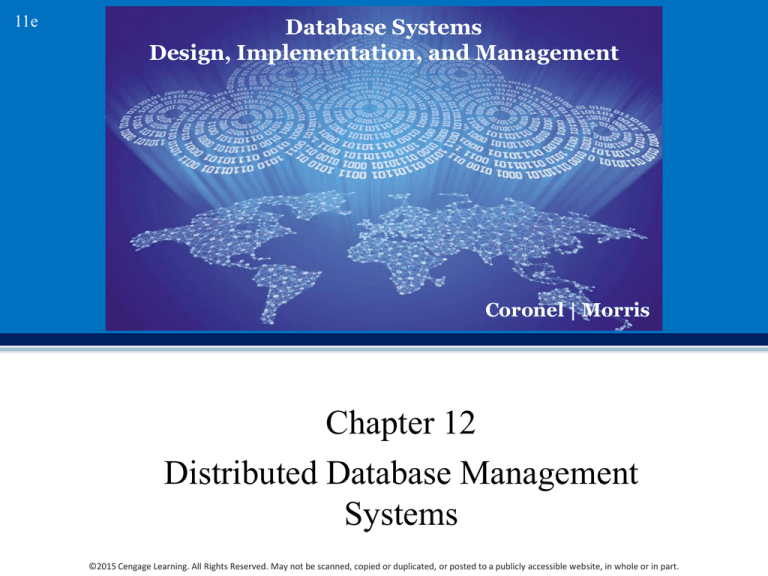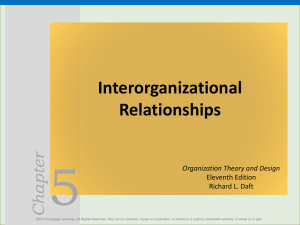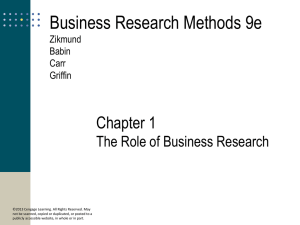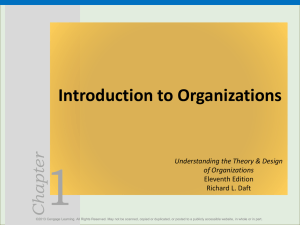
11e
Database Systems
Design, Implementation, and Management
Coronel | Morris
Chapter 12
Distributed Database Management
Systems
©2015 Cengage Learning. All Rights Reserved. May not be scanned, copied or duplicated, or posted to a publicly accessible website, in whole or in part.
Learning Objectives
In this chapter, the student will learn:
About distributed database management systems
(DDBMSs) and their components
How database implementation is affected by different
levels of data and process distribution
How transactions are managed in a distributed database
environment
©2015 Cengage Learning. All Rights Reserved. May not be scanned, copied or duplicated, or posted to a publicly accessible website, in whole or in part.
2
Learning Objectives
In this chapter, the student will learn:
How distributed database design draws on data
partitioning and replication to balance performance,
scalability, and availability
About the trade-offs of implementing a distributed data
system
©2015 Cengage Learning. All Rights Reserved. May not be scanned, copied or duplicated, or posted to a publicly accessible website, in whole or in part.
3
Evolution Database Management
Systems
Distributed database management system
(DDBMS): Governs storage and processing of
logically related data over interconnected computer
systems
Data and processing functions are distributed among
several sites
Centralized database management system
Required that corporate data be stored in a single
central site
Data access provided through dumb terminals
©2015 Cengage Learning. All Rights Reserved. May not be scanned, copied or duplicated, or posted to a publicly accessible website, in whole or in part.
4
Figure 12.1 - Centralized Database
Management System
©2015 Cengage Learning. All Rights Reserved. May not be scanned, copied or duplicated, or posted to a publicly accessible website, in whole or in part.
5
Factors Affecting the Centralized
Database Systems
Globalization of business operation
Advancement of web-based services
Rapid growth of social and network technologies
Digitization resulting in multiple types of data
Innovative business intelligence through analysis of
data
©2015 Cengage Learning. All Rights Reserved. May not be scanned, copied or duplicated, or posted to a publicly accessible website, in whole or in part.
6
Factors That Aided DDBMS to Cope
With Technological Advancement
Acceptance of Internet as a platform for business
Mobile wireless revolution
Usage of application as a service
Focus on mobile business intelligence
©2015 Cengage Learning. All Rights Reserved. May not be scanned, copied or duplicated, or posted to a publicly accessible website, in whole or in part.
7
Desirability of Distributed DBMS
Over Centralized DBMS
Performance
degradation
High costs
Scalability
problems
Reliability
problems
Organizational
rigidity
©2015 Cengage Learning. All Rights Reserved. May not be scanned, copied or duplicated, or posted to a publicly accessible website, in whole or in part.
8
Advantages and Disadvantages of
DDBMS
Advantages
• Data are located near
greatest demand site
• Faster data access and
processing
• Growth facilitation
• Improved communications
• Reduced operating costs
• User-friendly interface
• Less danger of a singlepoint failure
• Processor independence
Disadvantages
• Complexity of management
and control
• Technological difficulty
• Security
• Lack of standards
• Increased storage and
infrastructure requirements
• Increased training cost
• Costs incurred due to the
requirement of duplicated
infrastructure
©2015 Cengage Learning. All Rights Reserved. May not be scanned, copied or duplicated, or posted to a publicly accessible website, in whole or in part.
9
Distributed Processing and Distributed
Databases
Distributed processing: Database’s logical
processing is shared among two or more physically
independent sites via network
• Distributed database: Stores logically related
database over two or more physically independent
sites via computer network
Database fragments: Database composed of many
parts in distributed database system
©2015 Cengage Learning. All Rights Reserved. May not be scanned, copied or duplicated, or posted to a publicly accessible website, in whole or in part.
10
Characteristics of Distributed
Management Systems
Application
interface
Validation
Transformation
Query
optimization
Mapping
I/O interface
Formatting
Security
Backup and
recovery
DB
administration
Concurrency
control
Transaction
management
©2015 Cengage Learning. All Rights Reserved. May not be scanned, copied or duplicated, or posted to a publicly accessible website, in whole or in part.
11
Functions of Distributed DBMS
Receives the request of an application
Validates analyzes, and decomposes the request
Maps the request
Decomposes request into several I/O operations
Searches and validates data
Ensures consistency, security, and integrity
Validates data for specific conditions
Presents data in required format
©2015 Cengage Learning. All Rights Reserved. May not be scanned, copied or duplicated, or posted to a publicly accessible website, in whole or in part.
12
Figure 12.4 - A Fully Distributed Database
Management System
©2015 Cengage Learning. All Rights Reserved. May not be scanned, copied or duplicated, or posted to a publicly accessible website, in whole or in part.
13
DDBMS Components
Computer workstations or remote devices
Network hardware and software components
Communications media
• Transaction processor (TP): Software component of a
system that requests data
Known as transaction manager (TM) or application
processor (AP)
Data processor (DP) or data manager (DM)
Software component on a system that stores and
retrieves data from its location
©2015 Cengage Learning. All Rights Reserved. May not be scanned, copied or duplicated, or posted to a publicly accessible website, in whole or in part.
14
Single-Site Processing, Single-Site
Data (SPSD)
Processing is done on a single host computer
Data stored on host computer’s local disk
Processing restricted on end user’s side
DBMS is accessed by dumb terminals
©2015 Cengage Learning. All Rights Reserved. May not be scanned, copied or duplicated, or posted to a publicly accessible website, in whole or in part.
15
Figure 12.6 - Single-Site Processing,
Single-Site Data (Centralized)
©2015 Cengage Learning. All Rights Reserved. May not be scanned, copied or duplicated, or posted to a publicly accessible website, in whole or in part.
16
Multiple-Site Processing, Single-Site
Data (MPSD)
Multiple processes run on different computers
sharing a single data repository
Require network file server running conventional
applications
Accessed through LAN
Client/server architecture
Reduces network traffic
Processing is distributed
Supports data at multiple sites
©2015 Cengage Learning. All Rights Reserved. May not be scanned, copied or duplicated, or posted to a publicly accessible website, in whole or in part.
17
Figure 12.7 - Multiple-Site Processing,
Single-Site Data
©2015 Cengage Learning. All Rights Reserved. May not be scanned, copied or duplicated, or posted to a publicly accessible website, in whole or in part.
18
Multiple-Site Processing, Single-Site
Data (MPSD)
Fully distributed database management system
Support multiple data processors and transaction
processors at multiple sites
Classification of DDBMS depending on the level of
support for various types of databases
Homogeneous: Integrate multiple instances of same
DBMS over a network
Heterogeneous: Integrate different types of DBMSs
Fully heterogeneous: Support different DBMSs, each
supporting different data model
©2015 Cengage Learning. All Rights Reserved. May not be scanned, copied or duplicated, or posted to a publicly accessible website, in whole or in part.
19
Restrictions of DDBMS
Remote access is provided on a read-only basis
Restrictions on the number of remote tables that may
be accessed in a single transaction
Restrictions on the number of distinct databases that
may be accessed
Restrictions on the database model that may be
accessed
©2015 Cengage Learning. All Rights Reserved. May not be scanned, copied or duplicated, or posted to a publicly accessible website, in whole or in part.
20
Distributed Database Transparency
Features
Distribution
transparency
Transaction
transparency
Performance
transparency
Failure
transparency
Heterogeneity
transparency
©2015 Cengage Learning. All Rights Reserved. May not be scanned, copied or duplicated, or posted to a publicly accessible website, in whole or in part.
21
Distribution Transparency
Allows management of physically dispersed database
as if centralized
Levels
Fragmentation transparency
Location transparency
Local mapping transparency
©2015 Cengage Learning. All Rights Reserved. May not be scanned, copied or duplicated, or posted to a publicly accessible website, in whole or in part.
22
Distribution Transparency
Unique fragment: Each row is unique, regardless of
the fragment in which it is located
Supported by distributed data dictionary (DDD) or
distributed data catalog (DDC)
DDC contains the description of the entire database as
seen by the database administrator
Distributed global schema: Common database
schema to translate user requests into subqueries
©2015 Cengage Learning. All Rights Reserved. May not be scanned, copied or duplicated, or posted to a publicly accessible website, in whole or in part.
23
Transaction Transparency
Ensures database transactions will maintain
distributed database’s integrity and consistency
Ensures transaction completed only when all database
sites involved complete their part
Distributed database systems require complex
mechanisms to manage transactions
©2015 Cengage Learning. All Rights Reserved. May not be scanned, copied or duplicated, or posted to a publicly accessible website, in whole or in part.
24
Distributed Requests and Distributed
Transactions
Remote request
• Single SQL statement accesses data processed by a single remote
database processor
Remote transaction
• Accesses data at single remote site composed of several requests
Distributed transaction
• Requests data from several different remote sites on network
Distributed request
• Single SQL statement references data at several DP sites
©2015 Cengage Learning. All Rights Reserved. May not be scanned, copied or duplicated, or posted to a publicly accessible website, in whole or in part.
25
Distributed Concurrency Control
Concurrency control is important in distributed
databases environment
Due to multi-site multiple-process operations that
create inconsistencies and deadlocked transactions
©2015 Cengage Learning. All Rights Reserved. May not be scanned, copied or duplicated, or posted to a publicly accessible website, in whole or in part.
26
Figure 12.14 - The Effect of Premature
COMMIT
©2015 Cengage Learning. All Rights Reserved. May not be scanned, copied or duplicated, or posted to a publicly accessible website, in whole or in part.
27
Two-Phase Commit Protocol (2PC)
Guarantees if a portion of a transaction operation
cannot be committed, all changes made at the other
sites will be undone
To maintain a consistent database state
Requires that each DP’s transaction log entry be
written before database fragment is updated
DO-UNDO-REDO protocol: Roll transactions back
and forward with the help of the system’s transaction
log entries
©2015 Cengage Learning. All Rights Reserved. May not be scanned, copied or duplicated, or posted to a publicly accessible website, in whole or in part.
28
Two-Phase Commit Protocol (2PC)
Write-ahead protocol: Forces the log entry to be
written to permanent storage before actual operation
takes place
Defines operations between coordinator and
subordinates
Phases of implementation
Preparation
The final COMMIT
©2015 Cengage Learning. All Rights Reserved. May not be scanned, copied or duplicated, or posted to a publicly accessible website, in whole or in part.
29
Performance and Failure Transparency
Performance transparency: Allows a DDBMS to
perform as if it were a centralized database
Failure transparency: Ensures the system will
operate in case of network failure
Considerations for resolving requests in a distributed
data environment
Data distribution
Data replication
Replica transparency: DDBMS’s ability to hide multiple
copies of data from the user
©2015 Cengage Learning. All Rights Reserved. May not be scanned, copied or duplicated, or posted to a publicly accessible website, in whole or in part.
30
Performance and Failure Transparency
Network and node availability
Network latency: delay imposed by the amount of time
required for a data packet to make a round trip
Network partitioning: delay imposed when nodes
become suddenly unavailable due to a network failure
©2015 Cengage Learning. All Rights Reserved. May not be scanned, copied or duplicated, or posted to a publicly accessible website, in whole or in part.
31
Distributed Database Design
Data fragmentation
• How to partition database into fragments
Data replication
• Which fragments to replicate
Data allocation
• Where to locate those fragments and replicas
©2015 Cengage Learning. All Rights Reserved. May not be scanned, copied or duplicated, or posted to a publicly accessible website, in whole or in part.
32
Data Fragmentation
Breaks single object into many segments
Information is stored in distributed data catalog (DDC)
Strategies
Horizontal fragmentation: Division of a relation into
subsets (fragments) of tuples (rows)
Vertical fragmentation: Division of a relation into
attribute (column) subsets
Mixed fragmentation: Combination of horizontal and
vertical strategies
©2015 Cengage Learning. All Rights Reserved. May not be scanned, copied or duplicated, or posted to a publicly accessible website, in whole or in part.
33
Data Replication
Data copies stored at multiple sites served by a
computer network
Mutual consistency rule: Replicated data fragments
should be identical
Styles of replication
Push replication
Pull replication
Helps restore lost data
©2015 Cengage Learning. All Rights Reserved. May not be scanned, copied or duplicated, or posted to a publicly accessible website, in whole or in part.
34
Data Replication Scenarios
Fully replicated database
• Stores multiple copies of each database fragment at
multiple sites
Partially replicated database
• Stores multiple copies of some database fragments at
multiple sites
Unreplicated database
• Stores each database fragment at a single site
©2015 Cengage Learning. All Rights Reserved. May not be scanned, copied or duplicated, or posted to a publicly accessible website, in whole or in part.
35
Data Allocation Strategies
Centralized data allocation
• Entire database stored at one site
Partitioned data allocation
• Database is divided into two or more disjoined
fragments and stored at two or more sites
Replicated data allocation
• Copies of one or more database fragments are stored
at several sites
©2015 Cengage Learning. All Rights Reserved. May not be scanned, copied or duplicated, or posted to a publicly accessible website, in whole or in part.
36
The CAP Theorem
CAP stands for:
Consistency
Availability
Partition tolerance
Basically available, soft state, eventually consistent
(BASE)
Data changes are not immediate but propagate slowly
through the system until all replicas are consistent
©2015 Cengage Learning. All Rights Reserved. May not be scanned, copied or duplicated, or posted to a publicly accessible website, in whole or in part.
37
Table 12.8 - Distributed Database
Spectrum
Cengage Learning © 2015
©2015 Cengage Learning. All Rights Reserved. May not be scanned, copied or duplicated, or posted to a publicly accessible website, in whole or in part.
38
Key Assumptions of Hadoop
Distributed File System
High volume
Write-once,
read-many
Move
computations to
the data
Streaming access
Fault tolerance
©2015 Cengage Learning. All Rights Reserved. May not be scanned, copied or duplicated, or posted to a publicly accessible website, in whole or in part.
39
Figure 12.20 - Hadoop Distributed File
System (HDFS)
©2015 Cengage Learning. All Rights Reserved. May not be scanned, copied or duplicated, or posted to a publicly accessible website, in whole or in part.
40
C. J. Date’s Twelve Commandments
for Distributed Databases
Local site independence
Central site independence
Failure independence
Location transparency
Fragmentation transparency
Replication transparency
©2015 Cengage Learning. All Rights Reserved. May not be scanned, copied or duplicated, or posted to a publicly accessible website, in whole or in part.
41
C. J. Date’s Twelve Commandments
for Distributed Databases
Distributed query processing
Distributed transaction processing
Hardware independence
Operating system independence
Network independence
Database independence
©2015 Cengage Learning. All Rights Reserved. May not be scanned, copied or duplicated, or posted to a publicly accessible website, in whole or in part.
42








